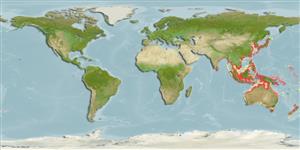Common names from other countries
Classification / Names / Names
ชื่อสามัญ | ชื่อพ้อง | Catalog of Fishes (gen., sp.) | ITIS | CoL | WoRMS
Environment: milieu / climate zone / depth range / distribution range
นิเวศวิทยา
กลุ่มสัตว์หน้าดิน,กลุ่มสัตว์พื้นท้องน้ำ; ระดับความลึก 0 - 50 m (Ref. 125642). Tropical, preferred 24°C (Ref. 107945)
Indo-West Pacific.
Length at first maturity / ขนาด / น้ำหนัก / Age
Maturity: Lm 13.1 range ? - ? cm Max length : 15.9 cm CW เพศผู้/กระเทย; (Ref. 125642)
Carapace tough to granulose, regions discernible; front with 3 acutely triangular teeth; 9 teeth on each anterolateral margin, the last tooth much larger than preceding teeth. Larger chela with conical tooth at base of fingers; pollex ridged. Color: carapace dull green to brown.
Minimum depth assumed from its ecology. Shallow waters up to depths of 50 m. Inhabits sandy to sandy-muddy substrates (Ref. 343). Benthopelagic predator, feeding mainly on bivalves (Lamellibranchia), benthic crustaceans, fishes and cephalopods (Ref. 117071).
Life cycle and mating behavior
วัยเจริญพันธุ์ | การสืบพันธุ์ | การวางไข่ | เซลสืบพันธ์ของเพศเมีย(ไข่) | ความดกของไข่ | ตัวอ่อน
Members of the order Decapoda are mostly gonochoric. Mating behavior: Precopulatory courtship ritual is common (through olfactory and tactile cues); usually indirect sperm transfer.
Ng, P.K.L. 1998. (Ref. 343)
IUCN Red List Status (Ref. 130435)
CITES status (Ref. 108899)
Not Evaluated
Not Evaluated
Threat to humans
Harmless
Human uses
การประมง: การค้า
FAO - การเพาะเลี้ยงสัตว์น้ำ: การผลิต; การประมง: landings, species profile | FishSource | ทะเลรอบๆเรา
เครื่องมือ
แหล่งที่มาจากอินเตอร์เน็ต
Estimates based on models
Preferred temperature
(Ref.
115969): 13.8 - 29.1, mean 28 (based on 1586 cells).
ความสามารถในการกลับคืนสู่ปกติ
ความสูง, เวลาต่ำสุดที่จะทำให้ประชากรเพิ่มขึ้นเป็น 2 เท่าใช้เวลาน้อยกว่า 15 เดือน (K=0.44-1.76).
Prior r = 1.19, 95% CL = 0.79 - 1.79, Based on 2 data-limited stock assessments.
Vulnerability
Low vulnerability (10 of 100).
